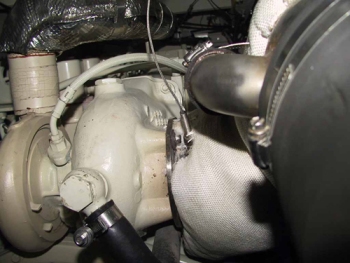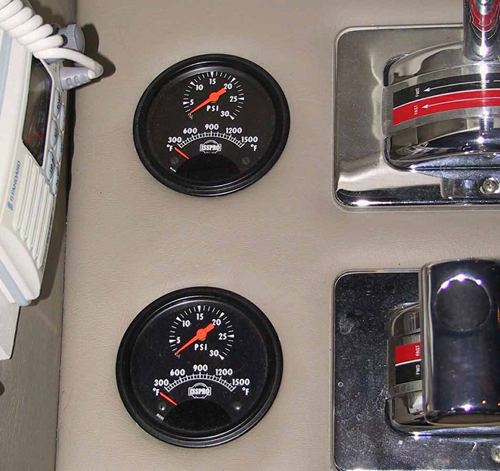MVDirona.com |
||
|
|
|
 |
Avoiding Diesel Engine Overload
By James Hamilton and Jennifer Hamilton
What you don't know about overloading your diesel engine probably won't kill you, but it might seriously damage your power plant and your pocketbook. Diesel engines have reputations for long lives, yet many marine diesels don't make it past the first thousand of hours of operation or couple of years of use. Diesels actually can live as long as their reputations and prices imply they should but, to achieve that goal, the three common diesel killers must be avoided: 1) poor operating environments— long-lived diesels operate in a clean, warm, and dry environment, 2) overheat— a long-lived diesel has never been overheated and its cooling system is maintained in peak condition, and 3) overload—a long-lived diesel has never experienced extended runs beyond its design parameters. It's this last issue, a very common life reducer in modern marine diesel engines, which we will look at in more detail in this article.
Characteristic signs of an overloaded diesel engine are excessive black smoke at cruising speed, exhaust temperatures beyond those specified by the manufacturer, and most importantly, an inability to reach full rated RPM at wide open throttle on a fully loaded boat with fuel and water tanks at capacity. Most boat and engine manufacturers do not supply adequate information regarding the potential for damaging the engine through overloading, and many in fact deliver boats that are likely to end up in this situation. Further, few provide gauge packages that would allow you to detect this problem. The instructions from boat manufacturers and from many diesel engine producers are to run the engines at cruise at no higher than 200 RPM off the maximum rated RPM. However, this advice is only correct if the propeller pitch is correct. When the pitch is excessive, this advice to "just run 200 RPM below the maximum rated RPM," can lead to serious damage and expensive overhauls.
Why would boat manufacturers configure their products such that diesel engine overload and subsequent short life is a likely outcome? In a word, it's marketing. Speed sells boats, and horsepower costs money, so manufacturers try to get as much speed as possible from a given boat/engine configuration. As a consequence, many manufacturers choose propeller pitch to obtain maximum speed with a clean and waxed hull, empty water and fuel tanks, and only one person on the boat. The pitch of the propeller determines how far your boat will move forward in the water on each shaft revolution (ignoring some loss due to propeller slippage). If you had no propeller pitch, the engine would hardly have to work at all, but your boat wouldn't go very fast either. The greater the pitch, the faster the boat will go for a given RPM, but the harder the engine has to work to achieve that RPM.
The propeller pitch is very similar to the gear selection in a manual transmission car. First gear in a car behaves like a low pitch propeller in a boat and, correspondingly, high gear in a car behaves like a high pitch propeller in a marine application. In fact, large ships and tugs often have variable pitch propellers for exactly this reason—the propeller pitch can be adjusted to properly match current speed and load conditions. However, most recreational boats have fixed pitch propellers and so pitch selection is particularly important. Without sufficient pitch, a boat will be slow but, with excessive pitch, the engines will be overloaded. Competitive pressure forces boat manufacturers to pitch propellers for maximum speed when new and, as a consequence, most boats have too much wheel pitch once the boat has been used for some time, the bottom is dirty, it's loaded up with water, fuel, spares, people, etc. This equation is what leads a large percentage of recreational boats to be over-propped (too much pitch) and the resultant overload condition can substantially shorten diesel engine life.
Consider our 40' Bayliner, equipped with a pair of Cummins 270B engines, which when delivered was 24,000 lbs, ran 23 kts at wide-open throttle, and cruised at just short of 20 kts. After a year of rigging, the boat weight had climbed to 29,700 lbs (although we wonder if the original 24,000 lb weight quoted in the sales literature was accurate). The propellers were 22x21x4: 22 inches in diameter, 21 inches of pitch, and four blades.
Like many manufacturers, Bayliner installs propellers on their boats that are designed to achieve good speeds on a lightly loaded vessel with a perfect bottom. As a consequence, these boats are right on the edge of an overload situation from the beginning. As the weight increases and the bottom becomes less than perfect, the engines end up working too hard. Most owners don't realize this and we probably wouldn't have either if Tony Athens at boatdiesel.com hadn't recommended that we ensure the engine could spin up, under load, to MORE than the rated RPM. Ours, rated at 2600 RPM, were still able to turn 2550 to 2575, but Tony insisted that anything less than rated RPM was unacceptable. The solution to this problem is to reduce the pitch of the propeller, in this case by an inch, thereby reducing the load on the engine.
Achievable engine RPM is a gross measure of overload—other excellent diagnostic aids are boost gauges to measure intake manifold boost pressure produced by the turbo charger and pyrometers to measure the engine exhaust temperature. They provide a more complete picture of engine load and allow for monitoring subtle changes over time. Most long-distance truckers, whose livelihood is directly tied to the health of their diesels engines, depend upon these additional sources of data. We use our boat heavily and want to make those engines last, so we felt the investment in this equipment would be well worth the cost and installation time. We selected ISSPRO (http://www.isspro.com/) gauges, but VDO (http://usa.siemensvdo.com/home) are also quite popular instruments.
Having installed these gauges, we learned that we were cruising at 2400 RPM with 26 PSI of boost and an exhaust gas temp of 850F on an engine where, at full rated HP, the exhaust temperature shouldn't exceed 802F. 26 PSI of boost is fairly high given that these engines at full rated HP produce only 30PSI and, as a point of comparison, our Mitsubishi 3000 sports car only produces 14 PSI of boost at full HP. Tony Athens recommends that these engines not exceed 20 PSI at cruise.
Figure 1: The gauges mounted at the lower helm conveniently display the intake manifold boost pressure produced by the turbo charger and exhaust temperature for each engine.
So our engines were somewhat overloaded, but not seriously so or, at least, not nearly as badly as many we've seen. Nonetheless, we took Tony's advice and removed an inch of pitch on my props, dropping from 22x21x4 to 22x20x4—both engines can now turn under load to 2675 RPM. We also reduced our cruise RPM from 2400 RPM to 2300—we now cruise at 20 PSI of boost with an exhaust gas temperature of 750F and a fuel consumption of 18.75 gallons per hour (9.3 GPH on each engine) down from over 22 GPH before reducing propeller pitch. The downside is that our cruise speed has fallen to just under 17 kts, but we need these engines to last and feel much better seeing them backed off to just under 70% load.
Figure 2: The exhaust gas temperature sensor installed just after the turbo charger in the 1/8" NPT fitting provided by Cummins in the factory exhaust risers.
Recently, the engines crossed 1,300 hours after three years of use and they appear to be in prime condition. Failures can still happen, but we're convinced that these changes substantially reduce the likelihood of the engines being hurt, and make it much more probable that we'll see thousands of trouble free hours. And, at the rate the hours are winding up, that's a good thing for us :-).
As an aside, engines that are overloaded tend to burn dirtier —we've becoming suspicious that all those boats with exhaust extensions to avoid sooting could instead benefit from a reduced load.
I strongly recommend boost gauges and pyrometers for everyone. Besides measuring engine load, they allow early detection of even small problems, such as the falling boost pressure and increasing exhaust gas temprature characteristic of a failing turbo charger, before the engines are damaged by the condition. If you want to learn more, check out boatdiesel.com— some very knowledgeable folks disseminate information on these forums.
If you have any questions or comments, feel free to contact James at JamesRH@computer.org.
Back to Diesel Engine Overload Introduction and Follow-up Questions
|
||
| Comments or questions? Feel free to contact us at Jennifer@mvdirona.com or jrh@mvdirona.com. |
Copyright 2012 Jennifer and James Hamilton |
|

